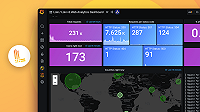Important: This documentation is about an older version. It's relevant only to the release noted, many of the features and functions have been updated or replaced. Please view the current version.
Install the Helm Chart
This Helm Chart installation runs the Grafana Loki cluster within a Kubernetes cluster.
If object storge is configured, this chart configures Loki to run read and write targets in a scalable mode, highly available architecture (3 replicas of each) designed to work with AWS S3 object storage. It will also configure meta-monitoring of metrics and logs.
It is not possible to run the scalable mode with the filesystem storage.
Before you begin:
- Helm 3 or above. See Installing Helm.
- A running Kubernetes cluster.
- A Prometheus operator installation in case meta-monitoring should be used.
- Optionally a Memcached deployment for better performance. Consult the caching section on how to configure Memcached.
To deploy Loki in scalable mode:
Add Grafana’s chart repository to Helm:
helm repo add grafana https://grafana.github.io/helm-chartsUpdate the chart repository:
helm repo updateConfigure the object storage:
Create the configuration file
values.yaml. The example below illustrates a s3 configuration:loki: storage: bucketNames: chunks: chunks ruler: ruler admin: admin type: s3 s3: endpoint: <endpoint> region: <AWS region> secretAccessKey: <AWS secret access key> accessKeyId: <AWS access key ID> s3ForcePathStyle: false insecure: falseConsult the Reference for configuring other storage providers.
If you’re just trying things, you can use the following configuration instead, that sets MinIO as storage:
minio: enabled: true
Install or upgrade the Loki deployment with this command.
helm install --values values.yaml loki grafana/loki # or upgrade for existing installations helm upgrade --values values.yaml loki grafana/loki



